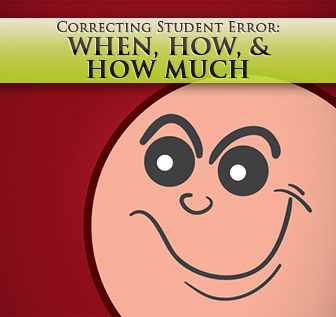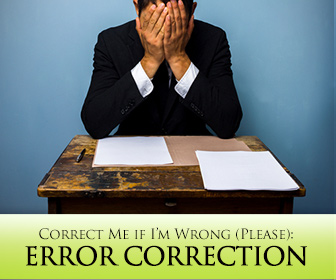Correcting Student Error in Writing and Speech: When, How, and How Much


They are never wrong, and if you think they are wrong, and produce evidence that they are wrong—well, both you and the evidence are wrong! (“Okay, today is not Mexican Independence Day--despite the students in traditional dress celebrating in the quad.”) These contrary students are there to contradict and argue the most minor of points.
But perhaps even worse than the student who never admits to being wrong and never accepts criticism is the student who wants to have all of her failings pointed out, no matter how minor. She would like you to interrupt her when talking to point out mistakes in pronunciation and grammar, and if you don’t do this it’s a sign that you are failing at your job as an instructor, Clearly some discussion is needed for such students, as well as the class as a whole, on the rationale for error correction and when it is appropriate.

Language, is after all, about communication, therefore the focus, especially in the beginning stages of language learning, should be on communicating clearly, if not with perfect accuracy, and in a variety of situations. For example, like many other American second language learners, I can communicate with a good deal of accuracy in my second languages of French and Russian on a limited number of topics: in almost anything related to school and other familiar topic like family, I have been told I have near-native control. But outside that limited range of topics, my ability to communicate breaks down because, again like many American second language learners, I was not allowed to progress to learning a new topic or level of conversation or writing until I had achieved near-perfect pronunciation and grammar in the current one. I would rather my students have a range of topics they can discuss and write about, comprehensibly if not perfectly.
Focusing on global errors is an academic way of saying “Pick your battles.” That is, it makes little sense to mark all the grammar errors in a student’s paper if there are numerous concerns with organization, development, and vocabulary that are going to force major revision anyway—creating a new set of grammar errors. Rather, do correcting in stages, first focusing on the global then perhaps the more “local” errors of articles and punctuation, for example.
Being interrupted while trying to communicate a message is a universally frustrating experience. I would never do it to a native speaker who happens to use a nonstandard form in online production, so I would not do it with a second language learner who is struggling to communicate. Rather, the student should be noticed for the effort and eventual success at communicating after she is finished and then as appropriate some concerns pointed out. This strategy has an additional benefit in that the concerns you point out—e.g., “be careful about dropped word endings”—is advice that will probably apply to most of the class, so no one is singled out, and the other students also benefit from the instruction.
Second language learners, especially those coming to the second language as adults, although capable of near-native like speech and writing and certainly proficient and comprehensible second language production, are still going to differ from native speakers. They will especially vary in the idiomatic, that part of language without a set of formal rules and which follow largely native speaker “intuition,” such as two-word verbs (I was given “the run around” or “the run about”?) These differences should be accepted, and some nonnative “accent” in both spoken and written production accepted, especially if it doesn’t interfere with meaning.

Error correction is really an instructional strategy, meant to help students improve their second language acquisition, so it is important to not only have a set of principles of error correction but also to be able to talk to students about your guiding principles: why you don’t correct every written or spoken error, for example. Many students expect and want each error corrected, and may become confused or frustrated if you don’t, perhaps doubting your competence as a teacher (you don’t correct because you yourself don’t know the correct form or because you don’t know how to mark a paper properly.) There are some methods to guide students in understanding error correction.
Fluency, the ability to speak or write without hesitation, is extremely important to general comprehensibility of the speaker or writer, probably more so than flawless production that proceeds very slowly for fear of making an error. In addition, aiming for flawless production probably limits acquisition: fewer vocabulary words and structures are attempted because risking use of new forms almost certainly results in errors at first.
Language acquisition does not come from being corrected. There is little evidence that correcting errors and focus on perfection will lead to acquisition. Rather, acquisition occurs in predictable steps and from continual engagement with the second language through practice in spoken and written tasks: correction doesn’t necessarily speed up this process. Error correction may actually be more practice for the teacher in the art of error correction than help for the students in acquisition of language.
Mistakes are part of the process. Taking risks, trying out new vocabulary and structures, is part of the progress of learning new language: trying it out, getting some focused feedback at the end, and trying again. Correcting every error, and focusing on the incorrect rather than correct, often encourages students to not take risks, to not speak up in English class, unless they know exactly how they should say it, for fear of the teacher interrupting them to explain a grammar or pronunciation point—which will develop the theoretical understanding of the point but probably not the use of it. Students can really only learn the use of a second language through actual use of, not the discussion of, it.
Because the teacher did not overtly correct you does not mean she didn’t correct you at all: rather, she might have modeled the correct form after the use, for example (“Oh, I see, you visited your friend yesterday?” or summed up at the end some general areas to work on: “Remember to check your word endings before handing in a paper.”) Because the teacher didn’t correct every error in your paper or dialogue does not mean she didn’t mark it at all. She may have focused on a couple of major problem areas to work on: repeated problems with verb tense, for example, rather than the one missing article.
Often an instructional strategy will not work if students are simply convinced that it won’t. If your students are used to having all of their errors corrected, try correcting students during production, or marking every error during a paper, and then ask how that works for them compared to the strategies of focused correction. Do they think that having every error pointed out helped them learn better? Often the answer is “no,” especially if they experienced the frustration of the teacher interrupting them while they were in the midst of communicating a complex thought. You may then refer to your original explanation of how and why you address student error. Or if students remain convinced of the value of correcting every error, you may continue doing this, while still trying to introduce them to more focused correction by sometimes using this strategy.
Giving students feedback is an art form, touching on values and expectations of both teacher and learner. There are some general principles of effective error correction, such as focusing on major concerns over minor and communication over correctness, that have been proven more effective than others and that should be introduced to students.